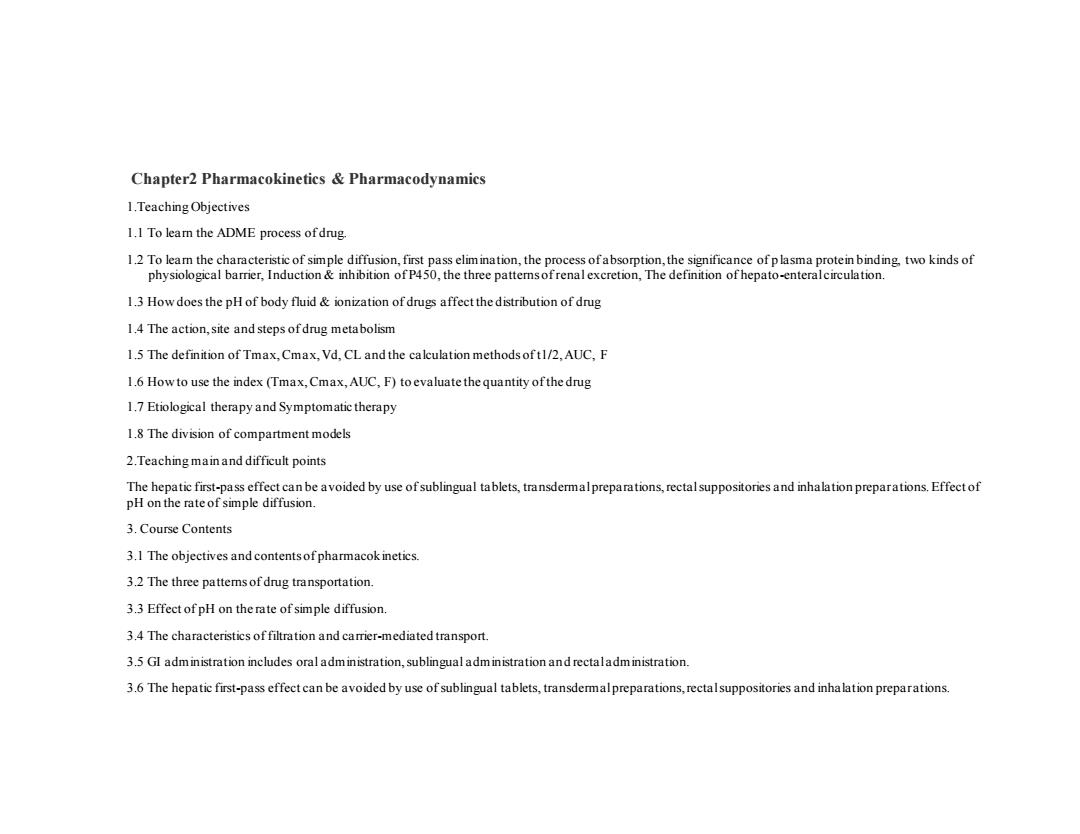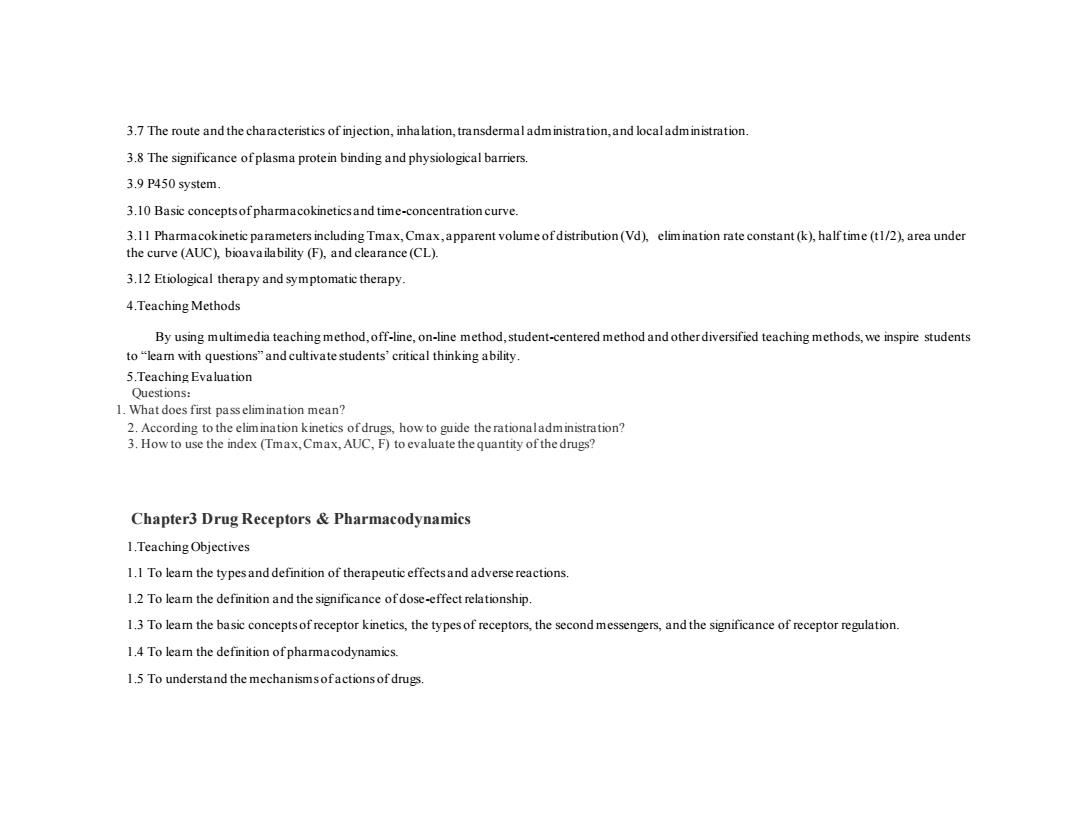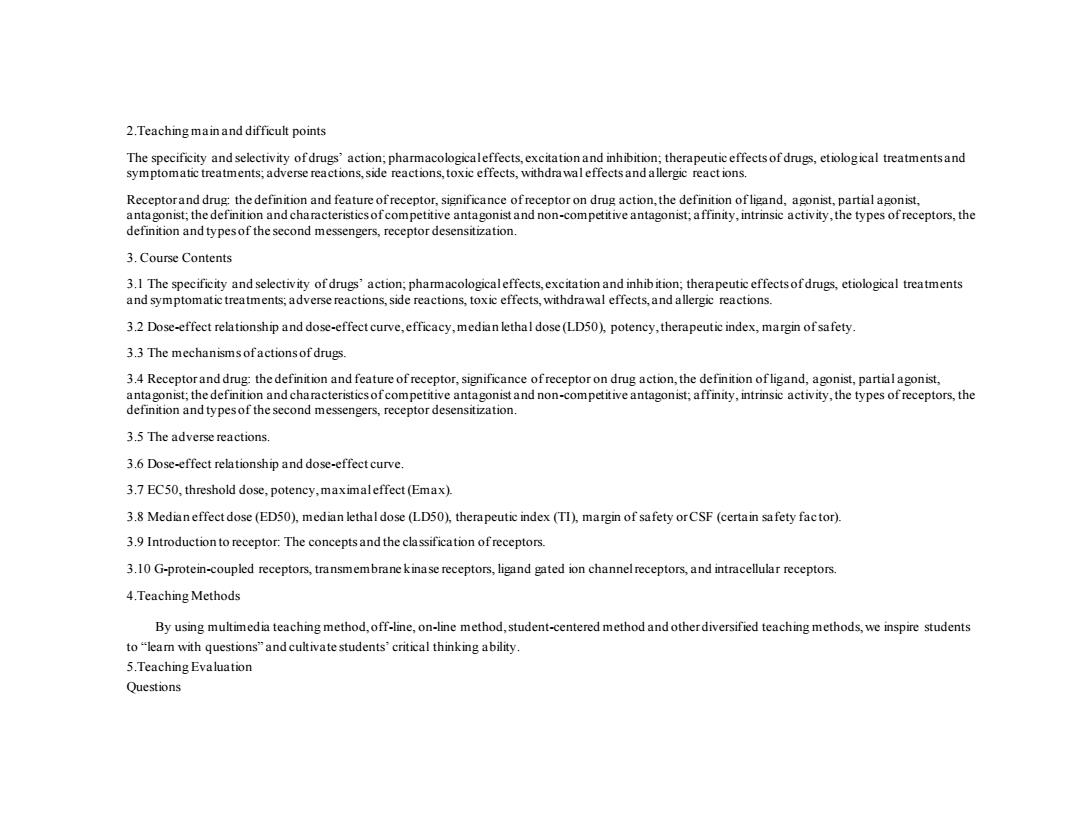
3. 教学内容 Chapter 1 Introduction 1.Teaching Objectives 1.1 To leam the definition ofdrug,pharmacology,pharmacodynamicsand pharmacokinetics. 1.2 To leam the principles ofdrug nomenclature. 1.3 To understand the developmentalhistory ofpharmacology. 2.Teaching main and difficult points The definitions and relationships between pharmacology and the two relevant displines of pharmacodynamics and pharmacokinetics. 3.Course Contents 3.1 The definitions and relationships between pharmacology and the two relevant disciplines of pharmacodynamicsand pharmacokinetics. 3.2 The developmentalhistory of pharmacology. 3.3 The definition and clinical applications of drugs. 3.4 Therapeutic,adverse,and toxic effects of drugs. 3.5 Principles ofdrug nomenclature. 3.6 Suggestions for pharmacology study. 4.Teaching Methods By using multimedia teaching method,off-line,on-line method,student-centered method and other diversified teaching methods,we inspire students to "leam with questions"and cultivate students'critical thinking ability. 5.Teaching Evaluation 5.1 Discussion What is drug?What is the relationship between pharmacodynamics and pharmacokinetics? 5.2 Questions
3. 教学内容 Chapter 1 Introduction 1.Teaching Objectives 1.1 To learn the definition of drug, pharmacology, pharmacodynamics and pharmacokinetics. 1.2 To learn the principles of drug nomenclature. 1.3 To understand the developmental history of pharmacology. 2.Teaching main and difficult points The definitions and relationships between pharmacology and the two relevant displines of pharmacodynamics and pharmacokinetic s. 3. Course Contents 3.1 The definitions and relationships between pharmacology and the two relevant discip lines of pharmacodynamics and pharmacokinetics. 3.2 The developmental history of pharmacology. 3.3 The definition and clinical applications of drugs. 3.4 Therapeutic, adverse, and toxic effects of drugs. 3.5 Principles of drug nomenclature. 3.6 Suggestions for pharmacology study. 4.Teaching Methods By using multimedia teaching method, off-line, on-line method, student-centered method and other diversified teaching methods, we inspire students to "learn with questions" and cultivate students' critical thinking ability. 5.Teaching Evaluation 5.1 Discussion What is drug? What is the relationship between pharmacodynamics and pharmacokinetics? 5.2 Questions

Chapter2 Pharmacokinetics Pharmacodynamics 1.Teaching Objectives 1.1 To learn the ADME process ofdrug. 1.2 To leam the characteristic of simple diffusion,first pass elimination,the process ofabsorption,the significance ofp lasma protein binding,two kinds of physiological barrier,Induction inhibition of P450,the three patternsofrenal excretion,The definition of hepato-enteralcirculation. 1.3 How does the pH of body fluid ionization of drugs affect the distribution of drug 1.4 The action,site and steps of drug metabolism 1.5 The definition of Tmax,Cmax,Vd,CL and the calculation methods oft1/2,AUC,F 1.6 How to use the index (Tmax,Cmax,AUC,F)to evaluate the quantity ofthe drug 1.7 Etiological therapy and Symptomatic therapy 1.8 The division of compartment models 2.Teaching main and difficult points The hepatic first-pass effect can be avoided by use of sublingual tablets,transdermalpreparations,rectal suppositories and inhalation preparations.Effect of pH on the rate of simple diffusion. 3.Course Contents 3.1 The objectives and contents of pharmacok inetics. 3.2 The three patterns of drug transportation. 3.3 Effect of pH on the rate of simple diffusion. 3.4 The characteristics of filtration and carrier-mediated transport. 3.5 GI administration includes oral administration,sublingual adm inistration and rectaladministration. 3.6 The hepatic first-pass effect can be avoided by use of sublingual tablets,transdermalpreparations,rectalsuppositories and inhalation preparations
Chapter2 Pharmacokinetics & Pharmacodynamics 1.Teaching Objectives 1.1 To learn the ADME process of drug. 1.2 To learn the characteristic of simple diffusion, first pass elimination, the process of absorption, the significance of p lasma protein binding, two kinds of physiological barrier, Induction & inhibition of P450, the three patterns of renal excretion, The definition of hepato-enteral circulation. 1.3 How does the pH of body fluid & ionization of drugs affect the distribution of drug 1.4 The action, site and steps of drug metabolism 1.5 The definition of Tmax, Cmax, Vd, CL and the calculation methods of t1/2, AUC, F 1.6 How to use the index (Tmax, Cmax, AUC, F) to evaluate the quantity of the drug 1.7 Etiological therapy and Symptomatic therapy 1.8 The division of compartment models 2.Teaching main and difficult points The hepatic first-pass effect can be avoided by use of sublingual tablets, transdermal preparations, rectal suppositories and inhalation preparations. Effect of pH on the rate of simple diffusion. 3. Course Contents 3.1 The objectives and contents of pharmacokinetics. 3.2 The three patterns of drug transportation. 3.3 Effect of pH on the rate of simple diffusion. 3.4 The characteristics of filtration and carrier-mediated transport. 3.5 GI administration includes oral administration, sublingual administration and rectal administration. 3.6 The hepatic first-pass effect can be avoided by use of sublingual tablets, transdermal preparations, rectal suppositories and inhalation preparations

3.7 The route and the characteristics of injection,inhalation,transdermal administration,and localadministration. 3.8 The significance ofplasma protein binding and physiological barriers. 3.9 P450 system. 3.10 Basic conceptsofpharmacokineticsand time-concentration curve. 3.11 Pharmacokinetic parameters including Tmax,Cmax,apparent volume ofdistribution(Vd),elimination rate constant(k),halftime(t1/2),area under the curve (AUC),bioavailability (F),and clearance(CL). 3.12 Etiological therapy and symptomatic therapy 4.Teaching Methods By using multimedia teaching method,off-line,on-line method,student-centered method and otherdiversified teaching methods,we inspire students to"leam with questions"and cultivate students'critical thinking ability. 5.Teaching Evaluation Questions: 1.What does first pass elimination mean? 2.According to the elimination kinetics of drugs,how to guide the rationaladministration? 3.How to use the index(Tmax,Cmax,AUC,F)to evaluate the quantity of the drugs? Chapter3 Drug Receptors Pharmacodynamics 1.Teaching Objectives 1.I To leam the types and definition of therapeutic effectsand adverse reactions. 1.2 To learn the definition and the significance ofdose-effect relationship. 1.3 To learn the basic conceptsof receptor kinetics,the types of receptors,the second messengers,and the significance of receptor regulation. 1.4 To learn the definition ofpharmacodynamics. 1.5 To understand the mechanismsofactions of drugs
3.7 The route and the characteristics of injection, inhalation, transdermal administration, and local administration. 3.8 The significance of plasma protein binding and physiological barriers. 3.9 P450 system. 3.10 Basic concepts of pharmacokinetics and time-concentration curve. 3.11 Pharmacokinetic parameters including Tmax, Cmax, apparent volume of distribution (Vd), elimination rate constant (k), half time (t1/2), area under the curve (AUC), bioavailability (F), and clearance (CL). 3.12 Etiological therapy and symptomatic therapy. 4.Teaching Methods By using multimedia teaching method, off-line, on-line method, student-centered method and other diversified teaching methods, we inspire students to “learn with questions” and cultivate students’ critical thinking ability. 5.Teaching Evaluation Questions: 1. What does first pass elimination mean? 2. According to the elimination kinetics of drugs, how to guide the rational administration? 3. How to use the index (Tmax, Cmax, AUC, F) to evaluate the quantity of the drugs? Chapter3 Drug Receptors & Pharmacodynamics 1.Teaching Objectives 1.1 To learn the types and definition of therapeutic effects and adverse reactions. 1.2 To learn the definition and the significance of dose-effect relationship. 1.3 To learn the basic concepts of receptor kinetics, the types of receptors, the second messengers, and the significance of receptor regulation. 1.4 To learn the definition of pharmacodynamics. 1.5 To understand the mechanisms of actions of drugs

2.Teaching main and difficult points The specificity and selectivity ofdrugs'action;pharmacologicaleffects,excitation and inhibition;therapeutic effects of drugs,etiological treatmentsand symptomatic treatments;adverse reactions,side reactions,toxic effects,withdrawal effectsand allergic react ions. Receptorand drug:the definition and feature ofreceptor,significance ofreceptor on drug action,the definition of ligand,agonist,partial agonist, antagonist;the definition and characteristics ofcompetitive antagonist and non-competitive antagonist,affinity,intrinsic activity,the types ofreceptors,the definition and types of the second messengers,receptor desensitization. 3.Course Contents 3.1 The specificity and selectivity of drugs'action;pharmacologicaleffects,excitation and inhib ition;therapeutic effects ofdrugs,etiological treatments and symptomatic treatments;adverse reactions,side reactions,toxic effects,withdrawal effects,and allergic reactions. 3.2 Dose-effect relationship and dose-effect curve,efficacy,median lethal dose(LD50),potency,therapeutic index,margin of safety 3.3 The mechanisms ofactions of drugs. 3.4 Receptor and drug:the definition and feature of receptor,significance of receptor on drug action,the definition of ligand,agonist,partial agonist, antagonist;the definition and characteristics ofcompetitive antagonist and non-competitive antagonist;affinity,intrinsic activity,the types of receptors,the definition and types of the second messengers,receptor desensitization. 3.5 The adverse reactions. 3.6 Dose-effect relationship and dose-effect curve. 3.7 EC50,threshold dose,potency,maximaleffect(Emax). 3.8 Medianeffect dose(ED50),median lethal dose(LD50),therapeutic index(TI),margin of safety or CSF(certain safety factor). 3.9 Introduction to receptor:The concepts and the classification ofreceptors. 3.10 G-protein-coupled receptors,transmembrane kinase receptors,ligand gated ion channel receptors,and intracellular receptors. 4.Teaching Methods By using multimedia teaching method,off-line,on-line method,student-centered method and other diversified teaching methods,we inspire students to"leam with questions"and cultivate students'critical thinking ability. 5.Teaching Evaluation Questions
2.Teaching main and difficult points The specificity and selectivity of drugs’ action; pharmacological effects, excitation and inhibition; therapeutic effects of drugs, etiological treatments and symptomatic treatments; adverse reactions, side reactions, toxic effects, withdrawal effects and allergic reactions. Receptor and drug: the definition and feature of receptor, significance of receptor on drug action, the definition of ligand, agonist, partial agonist, antagonist; the definition and characteristics of competitive antagonist and non-competitive antagonist; affinity, intrinsic activity, the types of receptors, the definition and types of the second messengers, receptor desensitization. 3. Course Contents 3.1 The specificity and selectivity of drugs’ action; pharmacological effects, excitation and inhib ition; therapeutic effects of drugs, etiological treatments and symptomatic treatments; adverse reactions, side reactions, toxic effects, withdrawal effects, and allergic reactions. 3.2 Dose-effect relationship and dose-effect curve, efficacy, median letha l dose (LD50), potency, therapeutic index, margin of safety. 3.3 The mechanisms of actions of drugs. 3.4 Receptor and drug: the definition and feature of receptor, significance of receptor on drug action, the definition of ligand, agonist, partial agonist, antagonist; the definition and characteristics of competitive antagonist and non-competitive antagonist; affinity, intrinsic activity, the types of receptors, the definition and types of the second messengers, receptor desensitization. 3.5 The adverse rea ctions. 3.6 Dose-effect relationship and dose-effect curve. 3.7 EC50, threshold dose, potency, maximal effect (Emax). 3.8 Median effect dose (ED50), median lethal dose (LD50), therapeutic index (TI), margin of safety or CSF (certain safety fac tor). 3.9 Introduction to receptor: The concepts and the classification of receptors. 3.10 G-protein-coupled receptors, transmembrane kinase receptors, ligand gated ion channel receptors, and intracellular receptors. 4.Teaching Methods By using multimedia teaching method, off-line, on-line method, student-centered method and other diversified teaching methods, we inspire students to “learn with questions” and cultivate students’ critical thinking ability. 5.Teaching Evaluation Questions

1.The significance of the EC50/ED50. 2.For anoptimalchoice of a drug,either potency or Emax is crucial? Chapter4Drug Biotransformation I.TeachingObjectives 1.1 To leam the key procedures of drug biotransformation. 1.2 To leam the roles of biotransformation in drug disposition 1.3 To leam the majororgans where drug biotransformation occurs. 1.4 To understand the enzymes involved in biotransformation. 2.Teaching main and difficult points 2.1 Human Liver P450 Enzymes 2.2 Induction inhibition of P450. 3.Course Contents 3.1.The roles ofbiotransformation. 3.2.Human Liver P450 Enzymes. Induction inhibition of P450. 3.3.Toxicity of Acetaminophen. 4.Teaching Methods By using multimedia teaching method,off-line,on-line method,student-centered method and other diversified teaching methods,we inspire students to"leam with questions"and cultivate students'critical thinking ability 5.Teaching Evaluation 5.1 Discussion
1. The significance of the EC50/ED50. 2. For an optimal choice of a drug, either potency or Emax is crucial? Chapter4Drug Biotransformation 1.Teaching Objectives 1.1 To learn the key procedures of drug biotransformation. 1.2 To learn the roles of biotransformation in drug disposition. 1.3 To learn the major organs where drug biotransformation occurs. 1.4 To understand the enzymes involved in biotransformation. 2.Teaching main and difficult points 2.1 Human Liver P450 Enzymes 2.2 Induction & inhibition of P450. 3. Course Contents 3.1. The roles of biotransformation. 3.2. Human Liver P450 Enzymes. Induction & inhibition of P450. 3.3. Toxicity of Acetaminophen. 4.Teaching Methods By using multimedia teaching method, off-line, on-line method, student-centered method and other diversified teaching methods, we inspire students to “learn with questions” and cultivate students’ critical thinking ability. 5.Teaching Evaluation 5.1 Discussion